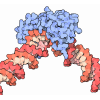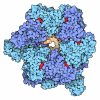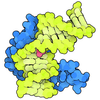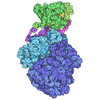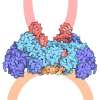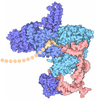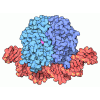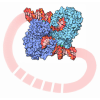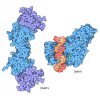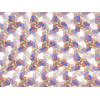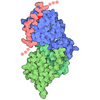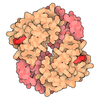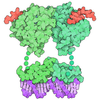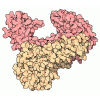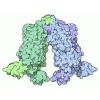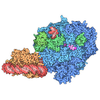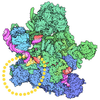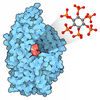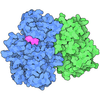[English] 日本語
 Yorodumi
Yorodumi- PDB-9q9k: Cryo-EM structure of human Mre11-Rad50 (MR) complex bound to DNA ... -
+ Open data
Open data
- Basic information
Basic information
| Entry | Database: PDB / ID: 9q9k | ||||||
|---|---|---|---|---|---|---|---|
| Title | Cryo-EM structure of human Mre11-Rad50 (MR) complex bound to DNA and telomeric factor TRF2 fragment (438-542) | ||||||
 Components Components |
| ||||||
 Keywords Keywords | HYDROLASE / Mre11-Rad50-TRF2 complex / double-strand DNA break repair protein / nuclease | ||||||
| Function / homology |  Function and homology information Function and homology informationchromosomal region / axonal transport of messenger ribonucleoprotein complex / negative regulation of telomere single strand break repair / telomeric 3' overhang formation / negative regulation of telomere maintenance via recombination / telomeric loop formation / mitochondrial double-strand break repair via homologous recombination / Mre11 complex / negative regulation of double-strand break repair via nonhomologous end joining / negative regulation of telomere capping ...chromosomal region / axonal transport of messenger ribonucleoprotein complex / negative regulation of telomere single strand break repair / telomeric 3' overhang formation / negative regulation of telomere maintenance via recombination / telomeric loop formation / mitochondrial double-strand break repair via homologous recombination / Mre11 complex / negative regulation of double-strand break repair via nonhomologous end joining / negative regulation of telomere capping / negative regulation of telomere maintenance via semi-conservative replication / BRCA1-C complex / Sensing of DNA Double Strand Breaks / negative regulation of telomeric D-loop disassembly / meiotic DNA double-strand break formation / protection from non-homologous end joining at telomere / regulation of mitotic recombination / RNA-templated DNA biosynthetic process / R-loop processing / Hydrolases; Acting on acid anhydrides / negative regulation of telomere maintenance / negative regulation of t-circle formation / single-stranded DNA endodeoxyribonuclease activity / chromosome organization involved in meiotic cell cycle / telomeric D-loop disassembly / shelterin complex / homologous chromosome pairing at meiosis / regulation of telomere maintenance via telomerase / Telomere C-strand synthesis initiation / DNA strand resection involved in replication fork processing / homologous recombination / nuclease activity / double-stranded telomeric DNA binding / G-quadruplex DNA binding / 3'-5'-DNA exonuclease activity / DNA double-strand break processing / Telomere C-strand (Lagging Strand) Synthesis / nuclear telomere cap complex / Impaired BRCA2 binding to PALB2 / single-stranded telomeric DNA binding / telomere maintenance via recombination / G-rich strand telomeric DNA binding / Cytosolic sensors of pathogen-associated DNA / mitotic G2/M transition checkpoint / telomere capping / HDR through MMEJ (alt-NHEJ) / IRF3-mediated induction of type I IFN / Processive synthesis on the C-strand of the telomere / Polymerase switching on the C-strand of the telomere / Removal of the Flap Intermediate from the C-strand / reciprocal meiotic recombination / mitotic intra-S DNA damage checkpoint signaling / regulation of telomere maintenance / Homologous DNA Pairing and Strand Exchange / Defective homologous recombination repair (HRR) due to BRCA1 loss of function / Defective HDR through Homologous Recombination Repair (HRR) due to PALB2 loss of BRCA1 binding function / Defective HDR through Homologous Recombination Repair (HRR) due to PALB2 loss of BRCA2/RAD51/RAD51C binding function / negative regulation of telomere maintenance via telomere lengthening / Resolution of D-loop Structures through Synthesis-Dependent Strand Annealing (SDSA) / protein localization to chromosome, telomeric region / sister chromatid cohesion / Resolution of D-loop Structures through Holliday Junction Intermediates / HDR through Single Strand Annealing (SSA) / Impaired BRCA2 binding to RAD51 / positive regulation of double-strand break repair / telomeric DNA binding / mitotic G2 DNA damage checkpoint signaling / negative regulation of telomere maintenance via telomerase / positive regulation of telomere maintenance / Presynaptic phase of homologous DNA pairing and strand exchange / negative regulation of cellular senescence / Telomere Extension By Telomerase / telomere maintenance via telomerase / Packaging Of Telomere Ends / Recognition and association of DNA glycosylase with site containing an affected purine / Cleavage of the damaged purine / 3'-5' exonuclease activity / Recognition and association of DNA glycosylase with site containing an affected pyrimidine / Cleavage of the damaged pyrimidine / telomere maintenance / Inhibition of DNA recombination at telomere / Meiotic synapsis / protein serine/threonine kinase activator activity / replication fork / condensed nuclear chromosome / DNA endonuclease activity / male germ cell nucleus / Nonhomologous End-Joining (NHEJ) / double-strand break repair via homologous recombination / PML body / G2/M DNA damage checkpoint / HDR through Homologous Recombination (HRR) / double-strand break repair via nonhomologous end joining / DNA Damage/Telomere Stress Induced Senescence / Meiotic recombination / cellular senescence / double-strand break repair / manganese ion binding / Recruitment and ATM-mediated phosphorylation of repair and signaling proteins at DNA double strand breaks / site of double-strand break Similarity search - Function | ||||||
| Biological species |  Homo sapiens (human) Homo sapiens (human) | ||||||
| Method | ELECTRON MICROSCOPY / single particle reconstruction / cryo EM / Resolution: 2.59 Å | ||||||
 Authors Authors | Cui, H.J. / Lammens, K. / Hopfner, K.P. / Fan, Y.L. / Kuybu, F. | ||||||
| Funding support |  Germany, 1items Germany, 1items
| ||||||
 Citation Citation |  Journal: Nat Commun / Year: 2025 Journal: Nat Commun / Year: 2025Title: Structural basis for DNA break sensing by human MRE11-RAD50-NBS1 and its regulation by telomeric factor TRF2. Authors: Yilan Fan / Filiz Kuybu / Hengjun Cui / Katja Lammens / Jia-Xuan Chen / Michael Kugler / Christophe Jung / Karl-Peter Hopfner /  Abstract: The MRE11-RAD50-NBS1 (MRN) complex is a central, multifunctional factor in the detection, signaling and nucleolytic processing of DNA double-strand breaks (DSBs). To clarify how human MRN binds ...The MRE11-RAD50-NBS1 (MRN) complex is a central, multifunctional factor in the detection, signaling and nucleolytic processing of DNA double-strand breaks (DSBs). To clarify how human MRN binds generic and telomeric DNA ends and can separate DNA end sensing from nuclease activities, we determined cryo-electron microscopy (cryo-EM) structures of human MRN bound to DNA and to DNA and the telomere protection factor TRF2. MRN senses DSBs through a tight clamp-like sensing state with closed coiled-coil domains, but auto-inhibited MRE11 nuclease. NBS1 wraps around the MRE11 dimer, with NBS1's ATM recruitment motif sequestered by binding to the regulatory RAD50 S site, necessitating a switch in the NBS1 C helix for ATM activation. At telomeric DNA, TRF2 blocks the second S site via the iDDR motif to prevent nuclease and ATM activation. Our results provide a structural framework for DNA sensing via a gating mechanism and separation of sensing, signaling and processing activities of mammalian MRN. | ||||||
| History |
|
- Structure visualization
Structure visualization
| Structure viewer | Molecule:  Molmil Molmil Jmol/JSmol Jmol/JSmol |
|---|
- Downloads & links
Downloads & links
- Download
Download
| PDBx/mmCIF format |  9q9k.cif.gz 9q9k.cif.gz | 473.7 KB | Display |  PDBx/mmCIF format PDBx/mmCIF format |
|---|---|---|---|---|
| PDB format |  pdb9q9k.ent.gz pdb9q9k.ent.gz | 351.9 KB | Display |  PDB format PDB format |
| PDBx/mmJSON format |  9q9k.json.gz 9q9k.json.gz | Tree view |  PDBx/mmJSON format PDBx/mmJSON format | |
| Others |  Other downloads Other downloads |
-Validation report
| Summary document |  9q9k_validation.pdf.gz 9q9k_validation.pdf.gz | 1.5 MB | Display |  wwPDB validaton report wwPDB validaton report |
|---|---|---|---|---|
| Full document |  9q9k_full_validation.pdf.gz 9q9k_full_validation.pdf.gz | 1.5 MB | Display | |
| Data in XML |  9q9k_validation.xml.gz 9q9k_validation.xml.gz | 71.1 KB | Display | |
| Data in CIF |  9q9k_validation.cif.gz 9q9k_validation.cif.gz | 108.4 KB | Display | |
| Arichive directory |  https://data.pdbj.org/pub/pdb/validation_reports/q9/9q9k https://data.pdbj.org/pub/pdb/validation_reports/q9/9q9k ftp://data.pdbj.org/pub/pdb/validation_reports/q9/9q9k ftp://data.pdbj.org/pub/pdb/validation_reports/q9/9q9k | HTTPS FTP |
-Related structure data
| Related structure data |  52962MC  9q9hC  9q9iC  9q9jC  9q9mC M: map data used to model this data C: citing same article ( |
|---|---|
| Similar structure data | Similarity search - Function & homology  F&H Search F&H Search |
- Links
Links
- Assembly
Assembly
| Deposited unit | 
|
|---|---|
| 1 |
|
- Components
Components
-Protein , 3 types, 6 molecules JKABDE
| #1: Protein | Mass: 12931.349 Da / Num. of mol.: 2 Source method: isolated from a genetically manipulated source Details: GP is the leftover sequence from PreScission cleavage site, and GGSSGGSSG is a linker sequence between the cleavage site and TRF2(438-542) fragment. Source: (gene. exp.)  Homo sapiens (human) / Gene: TERF2, TRBF2, TRF2 / Production host: Homo sapiens (human) / Gene: TERF2, TRBF2, TRF2 / Production host:  Trichoplusia ni (cabbage looper) / References: UniProt: Q15554 Trichoplusia ni (cabbage looper) / References: UniProt: Q15554#4: Protein | Mass: 154150.016 Da / Num. of mol.: 2 Source method: isolated from a genetically manipulated source Source: (gene. exp.)  Homo sapiens (human) / Gene: RAD50 / Production host: Homo sapiens (human) / Gene: RAD50 / Production host:  Trichoplusia ni (cabbage looper) / References: UniProt: Q92878 Trichoplusia ni (cabbage looper) / References: UniProt: Q92878#5: Protein | Mass: 84032.680 Da / Num. of mol.: 2 Source method: isolated from a genetically manipulated source Details: Following residue R708 is a short GS linker, a PreScission cleavage site, and two FLAG tags. Source: (gene. exp.)  Homo sapiens (human) / Gene: MRE11, HNGS1, MRE11A / Production host: Homo sapiens (human) / Gene: MRE11, HNGS1, MRE11A / Production host:  Trichoplusia ni (cabbage looper) Trichoplusia ni (cabbage looper)References: UniProt: P49959, Hydrolases; Acting on ester bonds |
|---|
-DNA chain , 2 types, 2 molecules PT
| #2: DNA chain | Mass: 19423.369 Da / Num. of mol.: 1 / Source method: obtained synthetically / Source: (synth.)  Homo sapiens (human) Homo sapiens (human) |
|---|---|
| #3: DNA chain | Mass: 20000.281 Da / Num. of mol.: 1 / Source method: obtained synthetically / Source: (synth.)  Homo sapiens (human) Homo sapiens (human) |
-Non-polymers , 5 types, 16 molecules 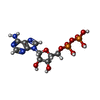

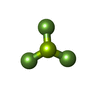

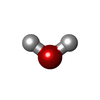




| #6: Chemical | | #7: Chemical | #8: Chemical | #9: Chemical | ChemComp-MN / #10: Water | ChemComp-HOH / | |
|---|
-Details
| Has ligand of interest | Y |
|---|---|
| Has protein modification | N |
-Experimental details
-Experiment
| Experiment | Method: ELECTRON MICROSCOPY |
|---|---|
| EM experiment | Aggregation state: PARTICLE / 3D reconstruction method: single particle reconstruction |
- Sample preparation
Sample preparation
| Component | Name: MR-TRF2(438-542)-DNA complex / Type: COMPLEX / Entity ID: #1-#5 / Source: RECOMBINANT |
|---|---|
| Molecular weight | Value: 0.52 MDa / Experimental value: NO |
| Source (natural) | Organism:  Homo sapiens (human) Homo sapiens (human) |
| Source (recombinant) | Organism:  Trichoplusia ni (cabbage looper) Trichoplusia ni (cabbage looper) |
| Buffer solution | pH: 7.5 Details: 25mM Hepes-NaOH, pH 7.5, 150 mM NaCl, 1 mM DTT, 1 mM ATP, 1mM BeF3, 5 mM MgCl2, 1 mM MnCl2 |
| Specimen | Embedding applied: NO / Shadowing applied: NO / Staining applied: NO / Vitrification applied: YES |
| Specimen support | Details: 20 mA, 7 s / Grid material: COPPER / Grid mesh size: 200 divisions/in. / Grid type: Quantifoil R2/1 |
| Vitrification | Instrument: LEICA PLUNGER / Cryogen name: ETHANE / Humidity: 95 % / Chamber temperature: 283 K |
- Electron microscopy imaging
Electron microscopy imaging
| Experimental equipment |  Model: Titan Krios / Image courtesy: FEI Company |
|---|---|
| Microscopy | Model: TFS KRIOS |
| Electron gun | Electron source:  FIELD EMISSION GUN / Accelerating voltage: 300 kV / Illumination mode: FLOOD BEAM FIELD EMISSION GUN / Accelerating voltage: 300 kV / Illumination mode: FLOOD BEAM |
| Electron lens | Mode: BRIGHT FIELD / Nominal defocus max: 2600 nm / Nominal defocus min: 500 nm / Cs: 2.7 mm |
| Specimen holder | Cryogen: NITROGEN |
| Image recording | Electron dose: 40 e/Å2 / Detector mode: COUNTING / Film or detector model: FEI FALCON IV (4k x 4k) |
| EM imaging optics | Energyfilter name: GIF Bioquantum / Energyfilter slit width: 20 eV |
| Image scans | Movie frames/image: 40 |
- Processing
Processing
| EM software |
| ||||||||||||||||||||||||||||||||||||||||
|---|---|---|---|---|---|---|---|---|---|---|---|---|---|---|---|---|---|---|---|---|---|---|---|---|---|---|---|---|---|---|---|---|---|---|---|---|---|---|---|---|---|
| CTF correction | Type: PHASE FLIPPING AND AMPLITUDE CORRECTION | ||||||||||||||||||||||||||||||||||||||||
| 3D reconstruction | Resolution: 2.59 Å / Resolution method: FSC 0.143 CUT-OFF / Num. of particles: 274928 / Symmetry type: POINT | ||||||||||||||||||||||||||||||||||||||||
| Atomic model building | Protocol: RIGID BODY FIT / Space: REAL | ||||||||||||||||||||||||||||||||||||||||
| Atomic model building | Source name: AlphaFold / Type: in silico model |
 Movie
Movie Controller
Controller







 PDBj
PDBj